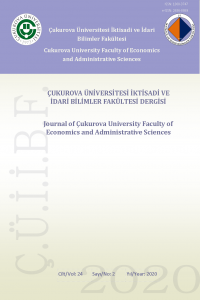An Investigation of Relation Between the Economic Development and Confidence in the Major Institutions
Economic development, Confidence in Institutions, Regression analysis
___
- Acemoglu, D. and Robinson, J. A. (2012), Why nations fail: Origins of power, properity and poverty, Great Britain, Profile Books Ltd.
- Alexander, A. Inglehart, R. & Welzel, C. (2011). “Measuring effective democracy: A defense”, World Values Research WVR, Volume 4 , Number 1, 1-39.
- Democracy index (2014), Democracy in retreat, A report from the Economist Intelligence Unit.
- Georgarakos, D. and Fürth,S. (2014). “Household repayment behavior: The role of social capital and institutional, political, and religious beliefs”. European Journal of Political Economy. In Press, http://dx.doi.org/10.1016/j.ejpoleco.2014.10.001
- Gonda, M. G. (2014).”Role of educational institutions in shaping the future of business and society”, Procedia Economics and Finance, 11, 635 – 641
- Kekic, Laza (2007), The Economist Intelligence Unit’s index of democracy, The World in 2007, 1-11.
- Lühiste, K. (2006). Explaining trust in political institutions: Some illustrations from the Baltic states. Communist and Post-Communist Studies. 39, 475-496.
- Sapsford R., Abbott, P. (2006). “Trust, confidence and social environment in postcommunist societies”, Communist and Post Comminist Studies, 39, 59-71.
- MacLeod,W.B. (2013). “On Economics: A review of why nations fail by D. Acemoglu and J. Robinson and pillars of prosperity by T. Besley and T. Persson”, Journal of Economic Literature, 51:1, 116–143.
- Nawaz, S. (2015). “Growth effects of institutions: A disaggregated analysis”. Economic Modelling, 45, 118–126.
- Shlapentokh, V. (2006). “Trust in public institutions in Russia: The lowest in the world”. Communist and Post-Communist Studies, 39, 153-174.
- Veise, Nima(2010). “Reconciling Acemoglu and Sachs: Geography, institutions and technology” Journal of International Affairs, Fall/Winter, Vol. 64, No. 1, 205- 220.
- Welzel, C. and Alexander A. C. (2008), “Measuring effective democracy: The human empowerment approach”. WVR 1(1):1-34.
- ISSN: 1300-3747
- Başlangıç: 1987
- Yayıncı: Çukurova Üniversitesi
Seçilmiş AB Ülkeleri için Gelir-Tüketim İlişkisi: Panel Veri Yaklaşımı
Mehmet ÖZMEN, Mehmet ÖKSÜZKAYA
Brent Petrol Fiyatının Havayolu Şirketlerinin Hisse Senedi Fiyatlarına Etkisi
Kemal EYÜBOĞLU, Sinem EYÜBOĞLU
Havaalanı Alışverişçileri ve Havaalanında Satın Almayı Etkileyen Durumsal Faktörler
Döviz Kurunun Yansıma Etkisi ve Yansıma Etkisinin Ölçülmesi: Türkiye Üzerine Bir Değerlendirme
AB-27 Ülkeleri İçin Gelir Yakınsamasının Mekânsal Ekonometrik Analiz İle Tahmini
F. İdil BAKTEMUR, Mehmet ÖZMEN
Küresel Kriz Sürecinde Gelişmiş ve Gelişmekte Olan Ekonomilerde Para Politikaları
Finansal Derinleşme ve Ekonomik Büyüme
